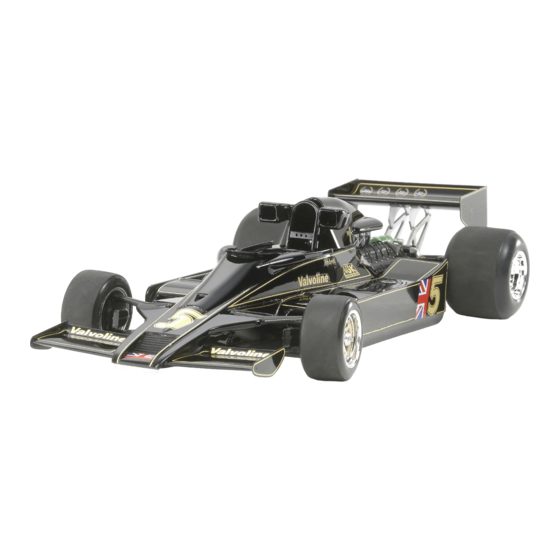
Werbung
Quicklinks
ITEM 20065
TEAM LOTUS EI9
n'
1/20
1
^H 1977 (
W
/
PH
°
T
°-
ETCHED
PARTS)
k. H-9X 5"C? 78 1977
Downforce is one of the fundamental factors on racing machines. It helps
increase ground traction and improve cornering, braking, and accelera-
tion performance. Most racing cars featured front and rear wings to
generate downforce. However, the Lotus Type 78, which was introduced
in December 1 976 as the successor to the Type 77, featured the adapta-
tion of the new "ground effect" design. Development of the Type 78
began in September 1 975 by a special group separated from the racing
team. Their basic development policy was to design a body that would
create downforce by itself and they focused on the airflow of the
underside of the machine. The existing design with the wedge-shaped
nose and side mounted radiators were drastically changed to incorpo-
Anpressdruck ist ein grundlegender Faktor bei Rennautos. Er erhoht die
Bodenhaftung und verbessert die Kurvenfahrt, das Bremsen und die
Beschleunigungsfahigkeit. Die meisten Rennwagen hatten Fron- und
Heckflugel zur Erzeugung von Anpressdruck. Der Lotus Typ 78, welcher
im Dezember 1976 als Nachfolger von Typ 77 vorgestellt wurde,
brachte die Einfiihrung der neuen ,,Bodeneffekt"-Konstruktion. Die
Entwicklung des Typ 78 begann im September 1975 durch eine vom
Rennteam getrennte Spezialgruppe. Ihre hauptsachliche Entwicklung-
saufgabe bestand darin, eine Karosserie zu entwickeln, die von sich aus
Anpressdruck erzeugen sollte und sie konzentrierten sich auf die
Luftstromung an der Unterseite des Boliden. Die bestehende Konstruk-
tion mit eckiger Nase und seitlich montierten Kuhlern wurde drastisch
verandert, um das neue Design zu verwirklichen. Der Typ 78 besaB ein
La force d'appui au sol est I'un des parametres essentiels d'une voiture
de competition. Elle permet d'accrottre la motricite et d'ameliorer les
performances en virage, freinage et acceleration. La plupart des
voitures de course comportaient des ailerons avant et arriere pour
generer cet appui. Cependant la Lotus Type 78 qui apparut en decem-
bre 1 976 pour succeder a la Type 77 avait un dispositif a "effet de sol".
Le developpement de la Type 78 avait commence en septembre 1975
par un groupe d'etude special independant du team de competition. La
final ite etait de concevoir une carrosserie qui genererait sa proper force
d'appui au sol et le groupe porta ses efforts sur I'ecoulement de I'air
sous la voiture. La configuration existante, avec un nez en biseau et
des radiateurs sur les cotes, fut radicalement modifiee. La Type 78
Hi -7
h'MWCilUIIUfcV'—
1976^12^,
rate the new design. The Type 78 featured a slim monocoque chassis and
side pontoons with undersurfaces shaped like inverted aircraft wings.
The airflow, where the clearance between the side pontoons and the
ground is smallest, generated downforce without creating air drag.
Furthermore, side skirts were attached to prevent airflow turbulence from
the sides of the body to maximize the effect. With all these new designs
implemented, the Type 78 displayed exceptional speed and cornering
performance. 1 977 saw Mario Andretti drive the Type 78 to victory at the
U.S.
West, Spanish, French, and Italian GPs and teammate Gunnar
Nilsson claim his first win at the Belgian GP. As the innovative ground
effect car, the Type 78 has forever left its name in racing history.
schmales Monocoque-Chassis und seitliche Pontons, deren Unterseite
wie umgekehrte Flugzeugfliigel ausgeformt waren. Die Luftstromung
erzeugte ohne Luftwiderstand da Anpressdruck, wo die Bodenfreiheit
an den Pontons am geringsten war. DarCiber hinaus wurden zur Maxim-
ierung des Effekts seitliche Schiirzen angebracht, welche eine Storung
der Stromung von den Karosserieseiten her verhindern sollten. Bei
Einsatz all dieser neuen Technik zeigte der Typ 78 auBergewohnliche
Geschwindigkeit und Kurvengangigkeit. 1977 fuhr Mario Andretti mit
dem Typ 78 beim
US-West, Spanischen,
Franzosischen und
Italienischen GP zum Sieg, sein Teamkollege Gunnar Nilsson schaffte
seinen ersten Sieg beim Belgischen GP. Als innovatives Bodeneffekt-
Auto hat der Typ 78 seinen Namen fiir immer in die Renngeschichte
eingebracht.
avait un fin chassis monocoque et des pontons lateraux dont la face
inferieure avait un profil d'aile d'avion inverse. Le flux d'air generait, la
ou la garde au sol est minimale, une force d'appui verticale sans
augmentation de la trainee. De plus, des jupes etaient fixees en bas des
pontons pour eviter les turbulences sur les cotes de la carrosserie et
optimiser I'effet de sol. Avec ces innovations, la Type 78 se montra
particulierement rapide et tres efficace en virage. En 1977, Mario
Andretti et sa Lotus 78 remporterent les GP des Etats Unis (Quest),
d'Espagne, de France et d'ltalie et son coequipier Gunnar Nilson
remporta sa premiere victoire au GP de Belgique. Voiture pionniere de
I'effet de sol, la Type 78 laissera sa trace dans I'histoire de la competi-
tion automobile.
bfco co-t-r F^^-y
D -
— A n —
0111 ©2011 TAMIYA
20065 1/20 LOTUS 78 '77 (w/PE Parts) (11052766)
Werbung













